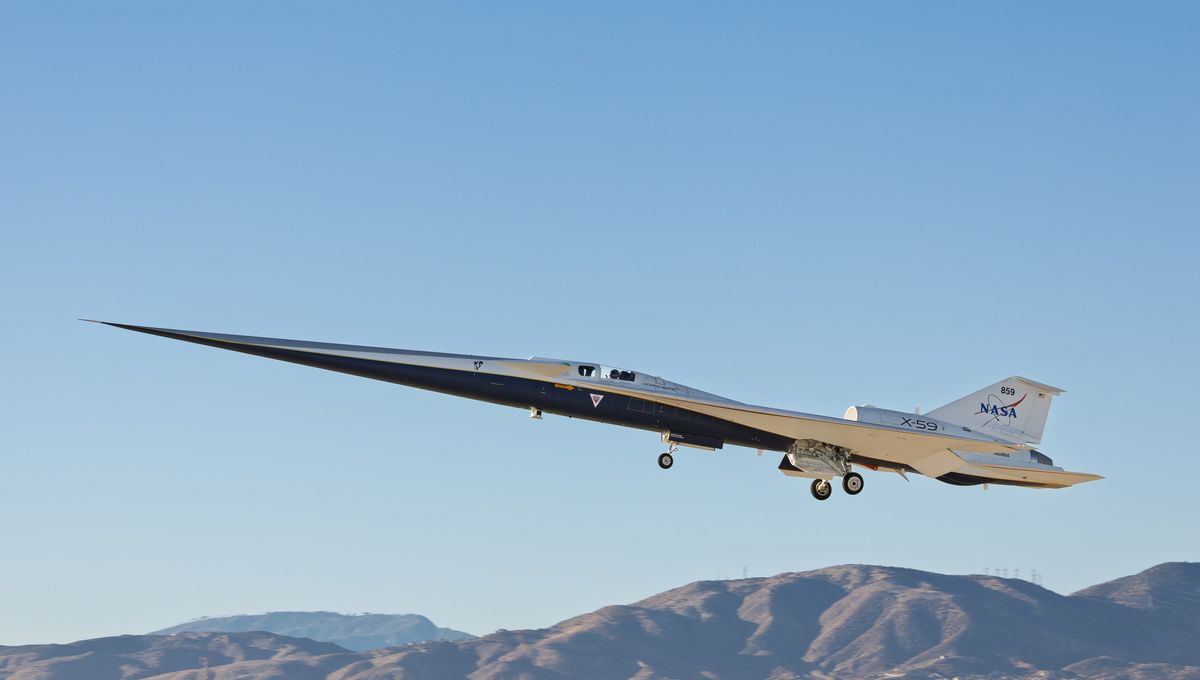
Shush! The era of quiet supersonic air travel is upon us. After years of development and setbacks, aeronautical engineers in the US flew the X-59, a “revolutionary” experimental aircraft designed to perform supersonic flight not with a sonic boom, but a hushed thump.
X-59 successfully completed its first flight at sunrise on Tuesday, October 28, 2025. The experimental aircraft set off from Palmdale Regional Airport and cruised for 36 kilometers (22 miles) over the Southern California desert while circling Edwards Air Force Base, where it landed safe and sound, according to aircraft tracker Flightradar24.
Developed by NASA in collaboration with Lockheed Martin, the X-59 is a 30.3-meter (just under 100-foot) aircraft that looks like a super-streamlined paper plane with a pointy nose. With further tweaking, it’s expected to reach 1.4 times the speed of sound in air, about 1,490 kilometers (925 miles) per hour. Crucially, however, it will break this so-called “sound barrier” without causing a sonic boom.
When a moving object breaks the sound barrier, it typically produces a thunderclap-like “bang,” caused by the buildup and sudden release of high-energy shock waves. This poses a major challenge for supersonic air travel, as the noisy shock waves can disturb cities, impact humans and animals, and even cause damage to buildings.
Owing to this issue, the US government effectively banned commercial flights of supersonic planes over its land in 1973. This restriction limited Concorde’s potential flight routes and added another obstacle to what was a massively hyped, but ultimately doomed, form of supersonic travel.
The ban has now been lifted, and it’s hoped that X-59 could be the spark that rekindles the fire. To address the noise problem of supersonic air travel, it has been designed with a unique shape that suppresses the sonic boom. Its long, tapered nose breaks up the pressure waves, transforming the explosive bang into a much milder thump.
Due to the ongoing federal government shutdown, NASA isn’t currently updating its website, so it didn’t publicly announce the recent mission’s success. However, Sean Duffy, acting NASA Administrator, made a brief comment about the test flight in a Lockheed Martin statement.
“X-59 is a symbol of American ingenuity. The American spirit knows no bounds. It’s part of our DNA – the desire to go farther, faster, and even quieter than anyone has ever gone before. This work sustains America’s place as the leader in aviation and has the potential to change the way the public flies,” said Duffy.
The X-59 was initially planned to take to the skies in 2023, but “several technical challenges” have meant its first test flight was pushed to this year. While there’s no word yet of whether it is close to achieving its hushed “sonic thump”, the team behind the test flight is apparently happy with its progress.
“We are thrilled to achieve the first flight of the X-59,” added OJ Sanchez, vice president and general manager of Lockheed Martin Skunk Works. “This aircraft is a testament to the innovation and expertise of our joint team, and we are proud to be at the forefront of quiet supersonic technology development.”
Source Link: Supersonic Flight Without The Boom: NASA's X-59 Experimental Aircraft Takes Flight For First Time